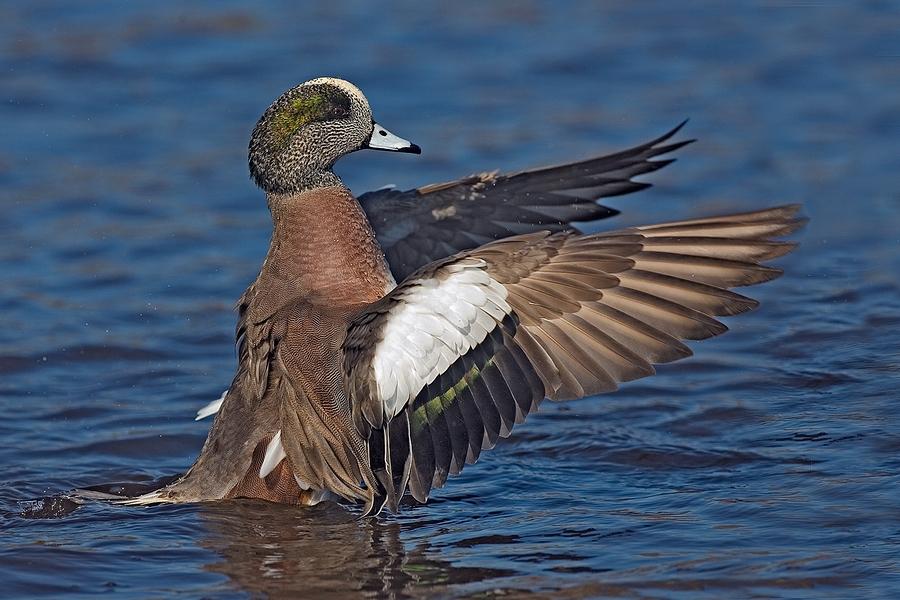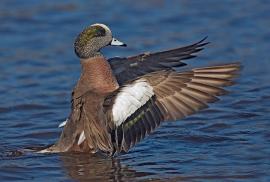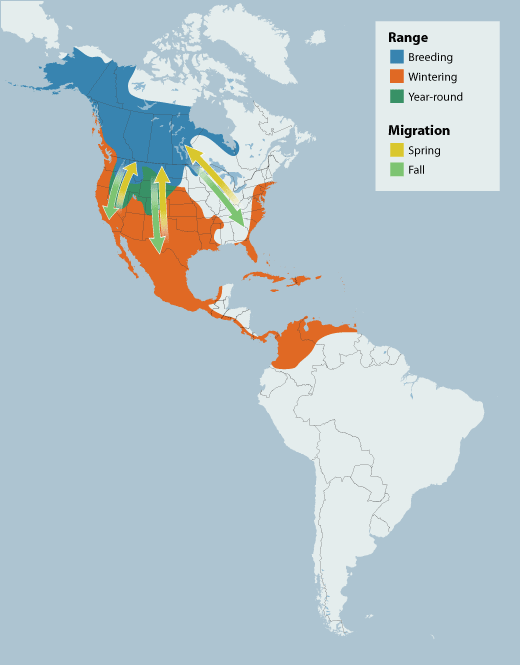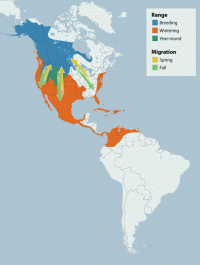Guide to Boreal Birds
This is an in-depth boreal species profile.
What is this?
This species is one of more than 30 birds selected for in-depth profiles. Find out why and see all selected boreal birds »
Overview
The American Wigeon is a wary bird, taking flight the instant it is disturbed; however the loud distinctive whistle it gives is usually a clear indicator. Flocks rise straight up from the surface of the water, uttering their whistling calls. They are often seen on marshy ponds in the company of diving birds such as coots, Redheads, and Canvasbacks. Wigeons wait at the surface while the other birds dive, then snatch the food away when the birds reappear. They also visit grain fields and meadows to graze like geese on tender shoots. Unlike many dabbling ducks, these birds often spend the night on large open bays, sleeping in rafts well out from shore.
After hitting a rough patch in the 1980s due to drought in the prairies, the American Wigeon has steadily recovered to become one of the most abundant dabbling ducks in North America, inhabiting every western province, territory and state. Also known as "baldpate," the breeding male has a distinctive white crown, along with a vibrant green eye patch that extends down its neck, and is highly recognizable in flight by his bold white shoulder patch. Both sexes have a short blue-grey bill with a black tip, white underbellies (conspicuous in flight), and a dark iridescent green speculum. As one of the most northerly breeders of all the dabbling ducks, the American Wigeon is a common visitor to the boreal forest.
Description
18-23" (46-58 cm). Male is brownish with white crown, green ear patch, and bold white shoulder patches easily visible in flight. Female is mottled brown with grayish head and whitish shoulder patches. Bill pale blue in both sexes.
Voice
Distinctive whistled whew-whee-whew; also quacks.
Nesting
9-11 whitish or cream-colored eggs in a down-lined nest of grass, often several hundred yards from water.
Habitat
Breeding Wigeon tend to choose sluggish rivers, marshes and shallow ponds with exposed shorelines and submergent vegetation, adjacent to dry meadows. When raising broods, American Wigeon prefer more open water, unlike most other dabbling species. Migrating Wigeon rely on small and large lakes, quiet rivers, flooded fields and protected freshwater inlets where food is plentiful. Winter habitat includes freshwater lakes, rivers, marshes and sheltered estuaries and bays.
Range/Migration
As one of the earliest waterfowl species to migrate south, most American Wigeon begin their journey to their wintering grounds in late August/early September. Although all four migration flyways are used, almost half of all wintering Wigeon use the Pacific Flyway, and are the most abundant dabbling duck along the coast of British Columbia.. Winter habitat is concentrated mainly on marshes, rivers, lakes, coastal estuaries and agricultural areas in southern British Columbia, the U.S., Central and South America, and the western Caribbean. American Wigeon tend to migrate in small flocks with other Wigeons, or in small flocks with gadwalls, mallards, and their unwitting thievery victims, American coots and other diving ducks.
Breeding
The Wigeon's breeding range is primarily in western Canada and Alaska; however, some breeding occurs in a few northwestern states. Although they are one of the earliest waterfowl to reach their wintering grounds, by this time male and female Wigeon have already formed pair bonds, with pair formation usually complete by February. Males have several courtship displays, such as swimming with heads thrust forward and wings pointed upwards, as well as facing the females with wings pointed upwards and dipping their bills into the water. An unseemly courting ritual is "the burp," in which the male emits high-pitched vocalization while stiffening his upper head feathers and his body in an erect posture, either ahead, behind, or beside a female. Like most ducks, American Wigeon are considered to be monogamous. Therefore, males usually stay with their mates through spring migration, nest selection, nest building and egg laying, leaving her alone at the end of incubation to group with other males and non-breeding females to molt.
Because it is a secretive duck and often nests in relatively remote landscapes, less is known about the American Wigeon's breeding habits. Nests are typically located on dry ground, up to 400m from the shoreline, where the nest can be carefully concealed in tall vegetation. Sometimes the female will nest in ground scrapes, lining the nest with leaf litter and covering the eggs with down when leaving to forage. The female will lay 9–12 eggs on average, and incubation occurs over approximately 25 days. Soon after her eggs have hatched, the female removes the precocial ducklings from the nest to the preferred brood habitat (mentioned above). Some species will allow other ducklings to join their broods; the female Wigeon, however, will aggressively prevent this, even with other Wigeon ducklings. To protect her brood from predators, the female will often use a distraction display, such as feigning wing injury, to distract the predator while her ducklings either dive or seek cover in surrounding vegetation, then fly off once the ducklings are concealed. Ducklings do not rely on their mother and feed themselves, relying on mostly insects for several weeks; eventually dabbling and consuming mostly aquatic vegetation. Females typically leave their young either before they fledge (approximately 6 weeks), or, if the female remains at the brood site to molt, after fledge.
Diet/Feeding Behavior
The American Wigeon's preferred foods are leaves and roots of submergent vegetation. As a dabbling duck, they are poor divers, making it difficult for them to obtain this food, so they do the next best thing: steal from those that can. Wigeon are often seen with diving species such as canvasbacks, redheads, scaup and coots, and they have also been known to steal from geese and even muskrats. They wait until these species dive to collect submergent vegetation, and then steal what they lose or sometimes snatch it straight from their mouths. As a result, the Wigeon has been nicknamed "the poacher." During the breeding and brood season, the American Wigeon's diet also consists of aquatic invertebrates, such as insects and mollusks; during migration, it will graze on upland grasses, clovers and some agricultural crops.
References
Bellrose, F.C. 1980. Ducks, geese, and swans of North America. Rev. ed. Stackpole Books, Harrisburg, Pennsylvania, USA.
Campbell, R.W., N.K. Dawe, I. McTaggart-Cowan, J.M. Cooper, G.W.Kaiser, M.C.E. McNall. 1990. The Birds of British Columbia. Volume 1: Nonpasserines. University of British Columbia Press, Vancouver, British Columbia, Canada.
Mowbray, T. 1999. American Wigeon. The Birds of North America. 401:1-31.
Partners in Flight. 2002. Species Assessment Database [online].http://www.rmbo.org/pif/pifdb.shtml
Seattle Audubon Society. 2002. BirdWeb: American Wigeon [online].http://www.birdweb.org/birdweb/species.asp?id=66
Semenchuk, G.P., editor. 1992. The Atlas of Breeding Birds of Alberta. Federation of Alberta Naturalists, Edmonton, Alberta, Canada.
Sibley, D. A. 2000. The Sibley Guide to Birds. Alfred A. Knopf, Inc., New York, New York, USA.
Sinclair, P.H., W.A. Nixon, C.D. Eckert and N.L. Hughes, editors. 2003. Birds of the Yukon Territory. University of British Columbia Press, Vancouver, British Columbia, Canada.
U.S. Fish and Wildlife Service. 2004. Waterfowl Population Status, 2004. U.S. Department of the Interior, Washington, D.C. USA.
Wilkins, K.A. and M.C. Otto. 2004. Trends in Duck Breeding Populations, 1955–2004 Administrative Report. U.S. Fish and Wildlife Service, Division of Migratory Bird Management, Laurel, Maryland, USA. Unpublished Report.
Credits
Birding content provided by National Wildlife Federation/eNature, with support from Ducks Unlimited/The Pew Charitable Trusts.





